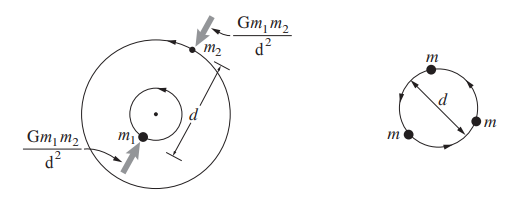problem16
16. Mechanics of two or more particles
- For two unequal particles with mass \(m_1\) and \(m_2\) what is the period of circular motion if the distance between the particles is \(d\) and the only force is the force between them is from classical inverse-square Newtonian gravity, \(F = Gm_1m_2/r^2\)?
- Pick numbers for \(G\), \(m_1\), \(m_2\) and \(r\) and, using appropriate initial conditions, test your analytical result with a numerical simulation. Make any plots needed to make the agreement of your numerical and analytical results convincing.
- For three equal particles, \(m_1 = m_2 = m_3 = 1\) and \(G = 10\) what is the angular speed for circular motion on a circle with diameter of \(d = 3\)?
- Check your result for three particles with a numerical simulation, as you did for 2 particles, above.
